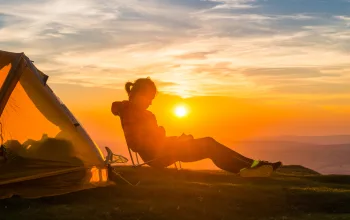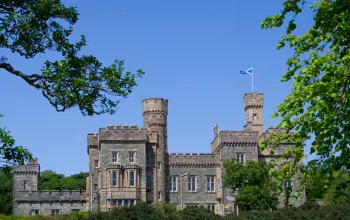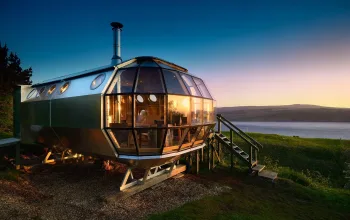Dominated by North Wales' most majestic mountains, Eryri National Park (the new Welsh-language name for Snowdonia National Park) is an adventure lover’s dream. The walking in Snowdonia is justifiably famous, and climbing Mount Snowdon should be on everyone's bucket list, but the national park isn't all about the hiking.
It's home to some incredible road and mountain biking routes, and a whole range of other attractions, from the world’s fastest zip line to an artificial wave pool—so you can try surfing miles from the coast—and even a trampoline in an underground cave. Such is the variety and range of attractions that you should never be bored of things to do in Snowdonia. Here are a few ideas to get you started.
Go Surfing at Surf Snowdonia

Who needs the sea to surf? If there are no waves breaking on the Welsh coast or if you just want to brush up on your skills, Surf Snowdonia’s manmade lagoon is the perfect place to grab a board and hit the water.
This huge pool has regular waves to suit all levels - if you’ve never surfed before, the beginner-sized waves are a great place to find your feet with an instructor, and if you’re a keen surfer, guaranteed intermediate and advanced waves rolling through every 90 seconds make it easy to catch wave after wave during your session.
Surf Snowdonia is part of the Adventure Parc, which also offers mountain biking, zip lining and cosy glamping pods. Beginner surf lessons start from £45.
Run the Snowdonia Marathon

There are marathons – and then there is the notoriously tough and hilly Snowdonia marathon. If you’ve hit the 26.2 mile running target before and are after a new challenge, running races don’t get more beautiful than this stomp through North Wales’ most beautiful mountain ranges.
Held each October, the Snowdonia Marathon starts and finishes in the Welsh village of Llanberis and encircles the Snowdon massif with a series of demanding climbs. It's not one for the faint-hearted!
Go Camping at some of Wales' most spectacular campsites

To really get under the skin of Snowdonia, spend a night under canvas in the national park’s wildest corners. There are plenty of campsites in the park, ranging from posh caravan parks with full amenities to semi-wild spots and farmer’s fields where you’ll pay a pittance to wake up to some of the most spectacular views in Britain.
The best Snowdonia camping spots? We love Owen Tyddyn’s farm at the base of Cadair Idris, the perfect base for climbing Mount Snowdon and for seeking out other things to do in Snowdonia, the luxury bell tents at Graig Wren, an eco-friendly woodland site, and the campsite at Aberafon, where you can sleep right on the coast and explore local beaches.
Climb Mount Snowdon

You can’t come to Eryri National Park without reaching the top of its most iconic mountain, Yr Wyddfa, aka Mount Snowdon. There are a variety of ways to get there, from the Snowdon mountain railway (the easiest option) to the challenging path over Crib Goch, a tricky but beautiful ridge line route to the top that is clad in white in winter.
Most people, however, take either the Pony path or the Pyg track, which are the easiest routes to the peak. Anyone who is reasonably fit should be able to make the summit in three hours. But whichever way you choose, make sure you're properly prepared to climb Mount Snowdon—the changeable weather can make even easy routes very challenging in a matter of a few minutes. Once at the summit, you can look out over miles of the National Park. Back down in the valley, the Pen-y-Gwryd pub is a mountaineer’s favourite, perfect for a post-hike celebratory pint.
Fly down the Snowdonia zip wire

Is it a bird? Is it a plane? Or is it a very brave soul zipping down Velocity 2, the fastest zip line in the world and one of Snowdonia National Park's top attractions? At Snowdonia’s Zip World you can strap in and fly head-first down a zip line above Penrhyn Quarry at a screaming 100 miles per hour.
Four simultaneous lines above the huge quarry mean you and your mates can take on the Velocity 2 together, which at 155 metres is also the longest zip line in Europe. There’s a cosy café on site if you need a restorative cuppa afterwards. From £89 per person.
Climb Cadair Idris

Ticked off Mount Snowdon? Set your sights on exploring Cadair Idris, a much-loved (and arguably more beautiful) peak near the town of Dolgellau in Eryri National Park, and top of our list of Snowdonia walks. The 893-metre summit makes for the perfect five-hour hike, and on hot days you can even stop off for a wild swim in Llyn Cau, the lake nestled below the summit.
On top you’ll see why Cadair Idris means ‘the chair of Idris the Giant’ – the horseshoe ridge is rather like a giant natural seat. There’s also a cosy little café and bookshop back down the trail near the car park.
Visit the Centre for Alternative Technology

Snowdonia National Park's Centre for Alternative Technology is an open-air site dedicated to showcasing a more sustainable way of life. Accessed via a water-powered cable car, the eco centre is the perfect place to explore of an afternoon if you’re keen to live more sustainably or brush up on the latest methods of green living, with displays of eco-friendly building methods and renewable energy, organic gardens and beautifully crafted examples of sustainable housing.
There’s also a great veggie café on site, and plenty of kid-friendly displays, making CAT one of our favourite places to visit in North Wales. Adults £6.50, children £3.
Go trampolining in a cave

You won’t find a weirder setting for a Snowdonia National Park day out (well, technically a day in) than Bounce Below in Blaenau Ffestiniog in North Wales, where six giant trampoline nets are spread out in a floodlit slate cavern. The cave, which was once a working Victorian mine, is twice the size of St Paul’s cathedral – a pretty amazing place to practise your backflip, and now one of North Wales' top attractions.
The space also holds huge slides and a zipline, making Bounce Below perfect for rainy days. Honestly, it sounds strange, but this is one of the best things to do in Snowdonia, especially if you've got kids (or are still just a big kid yourself).
Discover Snowdonia’s Waterfalls

There are plenty of incredible walks in Snowdonia National Park, many of which involve mountains like Cadair Idris (mentioned above). But the national park’s rugged landscapes are also home to another natural wonder – incredible cascading waterfalls.
There are plenty to discover, but Swallow Falls is one of Snowdonia’s most iconic cascades, and is easily reached on foot, starting from the village of Betws-y-Coed. Conwy Falls' white foamy water looks like it’s straight out of a fairy story, and is also close to Betws village, and tumbling Ceunant Mawr is a mile’s easy walk from Llanberis, making it a good shout for a relaxed family ramble. A waterfall walk is a must on our list of Snowdonia things to do.
Stay in a bothy

While bothies in Scotland are undoubtedly the original, they're not necessarily the best. Snowdonia National Park is also home to a handful of these shelters where hikers can spend a night in the wild. Walking into and out of a bothy makes for the perfect two-day adventure, packing in food (and maybe a cheeky bottle of wine) and waking up in the mountains - a great thing to do if you're feeling brave.
Bothies vary when it comes to amenities - don't expect luxury, but most offer sleeping platforms and a wood stove to warm up by. Arenig Fawr is a very basic little bothy in the mountains but does have an open fire, whereas Penrhos Isaf was once a farmhouse and is positively luxurious, with plenty of room and a wood stove.
Mountain bike Coed y Brenin

Coed y Brenin in Snowdonia National Park was the first UK forest to be specifically developed for mountain biking, and is also definitely one of the best, with singletrack trails to suit all levels and which are designed to be rideable in all weathers, so rain doesn’t need to stop play.
Explore the woodland’s blue, red and black singletrack mountain bike trails at whim by renting a bike, or brush up on your bike skills with an instructor and start in the dedicated skills area – either way, make sure to test your metal on the Falseteeth trail’s rolling ups and downs.





















